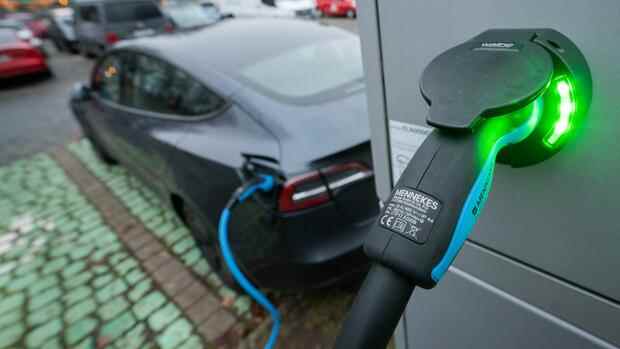From 2035, only zero-emission cars will be registered in the EU.
(Photo: dpa)
Berlin Volker Wissing (FDP) caused new confusion at the first meeting with his European colleagues in the Council of Transport Ministers. In Paris, the Federal Transport Minister said on Tuesday that the German government supports the EU Commission’s climate plans, which envisage a virtual end to the sale of new petrol and diesel vehicles from 2035.
Immediately afterwards, he restricted the commitment: the sale of combustion vehicles that are operated with so-called e-fuels should remain permitted. “We want to allow combustion engines that can only be fueled with synthetic fuels. There has to be a technical solution that guarantees that there is no way to fill them up with petrol and diesel,” said Wissing. “This is important for us in order to be technologically open.”
What now applies within the federal government? The coalition partners have been arguing about the interpretation of the coalition agreement for weeks. On the one hand, at least 15 million fully electric cars should be driving on German roads by 2030. On the other hand, Wissing does not want to adjust the rules with which the manufacturers have to comply with the limit values of their fleets under threat of severe penalties.
From 2035, only zero-emission cars and light commercial vehicles should be on the roads. That would be the bulk of the vehicles. This is what the EU Commission’s “Fit for 55” plans envisage. But Wissing then wants to continue allowing cars with combustion engines – “outside the fleet limits”. There is no doubt that even when cars are refueled with e-fuels, they emit emissions.
Top jobs of the day
Find the best jobs now and
be notified by email.
“The minister represented the common position of the federal government in Paris,” said a spokeswoman for the minister when asked. Actually, Chancellor Olaf Scholz (SPD) had spoken a word of power, according to which Germany supports the EU’s plans. However, reference is now being made to the coalition agreement with its contradictory statements.
They are no longer just causing confusion in Berlin, but also in Europe. “This is causing tempers in Europe to boil,” it said in Berlin government circles. Finally, after internal coalition squabbles, Germany seemed to have found a unified line. But it is anything but clear.
The Competition Council met this Thursday, and Italy wanted to submit an application on e-fuels. The Federal Ministry of Economics referred to the responsibilities in the round: The environmental council is in charge. In fact, the responsible working group of the Environment Council, which has to deal with the unclear German position, meets again on March 3rd.
Environment Minister does not want to count synthetic fuels against CO2 fleet limits
In contrast to Minister Wissing, Environment Minister Steffi Lemke (Greens) said after the supposed agreement on the traffic lights: “The use of e-fuels should not be counted towards the CO2 fleet limits in the future either. All in all, this means that the vast majority of vehicles on the road will switch to truly emission-free drives. This puts an end to a lengthy debate in the federal government.”
It is unclear what the vehicles are beyond the “most of them”. This is “the blind spot”, it was said in Berlin.
In any case, the EU Commission plans that from 2035 all passenger cars and all light commercial vehicles will no longer emit CO2, which means the end of the combustion engine. Only trucks or special vehicles such as ambulances may remain. “In road traffic, electromobility is the most efficient, cost-effective alternative for more climate protection. Electricity-based fuels should be used where there are no climate-friendly alternatives, especially in air and sea transport,” Lemke said.
In government circles it was said that the position of the Ministry of Transport was difficult to understand in view of the required climate targets for 2030 and the agreed 15 million fully electric cars. After all, the transport sector, even with so many e-mobiles, will still emit too much CO2 that needs to be saved. Ambitious limit values are the easiest way and would only pave the way so that 15 million cars would actually be sold.
More: Too small, too tight, too dilapidated: why the rail network is collapsing

